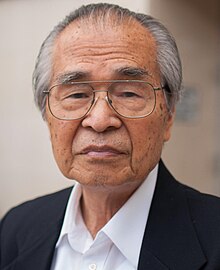Masatoshi Nei
| Masatoshi Nei | |
|---|---|
 |
|
| Born |
January 2, 1931 (age 86) Miyazaki Prefecture, Japan |
| Nationality |
|
| Fields |
molecular evolution molecular phylogenetics |
| Institutions |
Temple University Pennsylvania State University University of Texas at Houston Brown University National Institute of Radiological Sciences Kyoto University |
| Alma mater |
Kyoto University University of Miyazaki(1953) |
| Known for | Statistical theories of molecular evolution and development of the theory of mutation-driven evolution |
| Notable awards | Kyoto Prize (2013) Thomas Hunt Morgan Medal (2006) Barbara Bowman Award (2003) International Prize for Biology (2002) Member, National Academy of Sciences (1997) Kihara Prize(1990) Rockefeller Foundation Fellowship (1961) |
Masatoshi Nei (根井正利 Nei Masatoshi?) is currently affiliated with the Department of Biology at Temple University as a Carnell Professor. He was, until recently, Evan Pugh Professor of Biology at Pennsylvania State University and Director of the Institute of Molecular Evolutionary Genetics and had been there from 1990 to 2015.
He was born in 1931 in Miyazaki Prefecture, on Kyūshū Island, Japan. He was associate professor and professor of biology at Brown University from 1969 to 1972 and professor of population genetics at the Center for Demographic and Population Genetics, University of Texas at Houston, from 1972 to 1990. He is a theoretical population geneticist and evolutionary biologist. Acting alone or working with his students, he has continuously developed new statistical theories of molecular evolution taking into account frontier knowledge of molecular biology. He has also developed several new concepts of evolutionary theory and proposed the theory of mutation-driven evolution.
He is the first to show mathematically that in the presence of gene interaction natural selection always tends to enhance the linkage intensity between genetic loci or maintain the same linkage relationship. He then observed that the average recombination value per genome is generally lower in higher organisms than in lower organisms and attributed this observation to his theory of linkage modification. Recent molecular data indicate that many sets of interacting genes such as Hox genes, immunoglobulin genes, and histone genes have often existed as gene clusters for a long evolutionary time. This observation can also be explained by his theory of linkage modification. He also showed that, unlike R. A. Fisher’s argument, deleterious mutations can accumulate rather quickly on the Y chromosome or duplicate genes in finite populations. In 1969, considering the rates of amino acid substitution, gene duplication, and gene inactivation, he predicted that higher organisms contain a large number of duplicate genes and nonfunctional genes (now called pseudogenes). This prediction was shown to be correct when many multigene families and pseudogenes were discovered in the 1980s and 1990s. His notable contribution in the early 1970s is the proposal of a new measure of genetic distance (Nei’s distance) between populations and its use for studying evolutionary relationships of populations or closely related species. He later developed another distance measure called DA, which is appropriate for finding the topology of a phylogenetic tree of populations. He also developed statistics of measuring the extent of population differentiation for any types of mating system using GST measure. In 1975, he and collaborators presented a mathematical formulation of population bottleneck effects and clarified the genetic meaning of bottleneck effects. In 1979, he proposed a statistical measure called nucleotide diversity, which is now widely used for measuring the extent of nucleotide polymorphism. He also developed several different models of speciation and concluded that the reproductive isolation between species occurs as a passive process of accumulation of interspecific incompatibility mutations
...
Wikipedia
